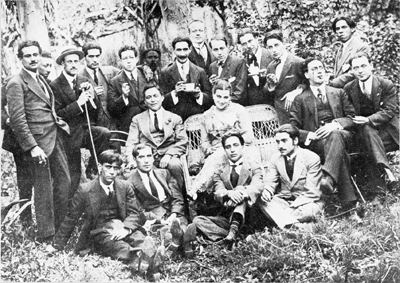 | ||
Generación del 13 (Generación del Trece; The 13 Generation) was Chile's first painter collective. Its name derives from the year 1913, after a joint exhibition was held at the Salon of the Chilean newspaper El Mercurio in the preceding year. The group and its work are characterized by a fascination with Creole art and customs, social criticism, and portrayal of the proletariat, a subject that hitherto was not depicted in Chilean art.
Contents
History
At the beginning of the 20th century, alongside the celebration of the first 100 years of independence, Chile experienced a period where art began to be more widely appreciated by many people (among the upper classes, at least). There was a rush to beautify Chile's cities, although the influx of thousands of rural people to the cities in search of work, social problems were increasing. The 13 Generation established itself in 1913 after participating in the "Salones de El Mercurio". These new Chilean painters – The 13 Generation – had emerged from the lower classes. Disciples of Pedro Lira, they formed a painting academy at the Catholic University of Chile while studying at the Academy of Fine Arts.
Many members of The 13 Generation studied at the Academy of Fine Arts, under Fernando Álvarez de Sotomayor, a notable Spanish painter who took charge of the Academy during the period of 1910–1915, after the departure of Virginio Arias. According to the art critic Luis Álvarez Urquieta, "the efforts of Alvarez de Sotomayor at our school could not have been more fruitful; he reformed its rules, almost doubled the number of registered students, and trained many who were a hope for the future of our art". Though they were poor, The 13 Generation was incentivised and educated to put their personality into their work and paint about poverty and the lower classes, considered taboo topics at the time. They also portrayed the lives of farmers, workers and popular traditions. The 13 Generation did not achieve a permanent change in the parameters of art in Chile; this came later, with the Grupo Montparnasse, and the "Generación del 28" (28 Generation).
Style
The works of The 13 Generation were in the Post-romanticism style. Their landscapes and portraits were created independently of international trends. They painted themes devoted to the social landscape, the life of poverty and common people. Moving away from traditional themes, they maintained certain concepts, such as respect for accurate representation of volume and colour, and technical expertise in painting the human form. They also explored melancholy as a theme with rich dark colours, broad brush strokes, and less detailed forms which were sketched masterfully. They became dedicated to portraiture, paying less attention to religion and abandoning mythological themes. Their use of red became their signature, combined with deep greens and earthy colours. The use of light was important to this group, showing some details that were reminiscent of the Spanish style inherited from their teacher. Their use of colours moved them closer to a Realist style. Even though the group shared many common characteristics, many of its student members had a very strong signature style. This was the case for both Arturo Gordon and Pedro Luna, whose styles were drastically different even though they were also two of the most notable members of the 13 Generation.
Legacy
The 13 Generation was the first Chilean artistic group to reach a uniformity of style. Its members – bohemians and admirers of Spanish masters – modified the academic conventions with opaque bitumens and contrasting colours. Although their influence was small among Chilean aristocracy, their work has remained a representation of one of the hardest times for the working class, the poor, farmers and the Mapuche people. Almost all of its members died young and it would be their contemporaries, the Grupo Montparnasse, who would eventually overtake the School of Fine Arts to become set a new standard of painting in Chile. Since 1945, the painting of The 13 Generation has been recognized in originality and merit. There have been several studies of their works and their sensibilities, especially those of the most popular members of the group, Arturo Gordon and Pedro Luna, whose works are highly valued in the Chilean art market. The 13 Generation began the art trend of Arte campesino, while under the influence of the Spanish style taught by Alvarez de Sotomayor. One of their most notable achievements was to demonstrate that it was possible for impoverished artists with little training to produce high quality paintings.
Various nicknames are associated with The 13 Generation. "Generación del Centenario" ("Centenary Generation") or "El grupo del Centenario" corresponds with the Chilean Centennial, although only one member of the collective, Ezequiel Plaza, was entered into the inaugural exhibition of the Museum of Fine Arts on September 21, 1910. Álvarez de Sotomayor's influence was so important upon the group that in the Ministry of Education's retrospective of The 13 Generation, it referred to the group as "Generation Alvarez de Sotomayor". "Generación trágica" ("Tragic Generation") was inspired by of the early deaths of some of its members.
Several museums hold collections of The 13 Generation, such as Casa del Arte, Concepción; Chilean National Museum of Fine Arts (Museo Nacional de Bellas Artes or MNBA), Santiago de Chile; and Museo Histórico O'Higginiano, Talca. One of the largest collections is held by the University of Chile after its 1958 acquisition of the pieces held by Julio Vásquez Cortez.
Members
Various authors have identified the following as the most representative members of The 13 Generation. At least one author has mentioned that the group was made up of approximately twenty artists, including students from the University of Chile.
